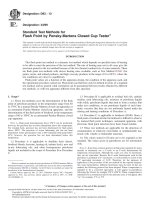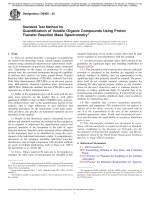ASTM D279-02 (2023) Standard Test Methods for Bleeding of Pigments
Bạn đang xem bản rút gọn của tài liệu. Xem và tải ngay bản đầy đủ của tài liệu tại đây (198.13 KB, 2 trang )
This international standard was developed in accordance with internationally recognized principles on standardization established in the Decision on Principles for the
Development of International Standards, Guides and Recommendations issued by the World Trade Organization Technical Barriers to Trade (TBT) Committee.
Designation: D279 − 02 (Reapproved 2023)
Standard Test Methods for
Bleeding of Pigments1
This standard is issued under the fixed designation D279; the number immediately following the designation indicates the year of
original adoption or, in the case of revision, the year of last revision. A number in parentheses indicates the year of last reapproval. A
superscript epsilon (´) indicates an editorial change since the last revision or reapproval.
This standard has been approved for use by agencies of the U.S. Department of Defense.
1. Scope 3.2 Test Method B—A coating using the pigment under test
is prepared and applied to one half of a panel. A white finish is
1.1 These test methods cover procedures for determining applied over the dried colored coating and extended to the
the bleeding characteristics of dry pigments by direct solvent uncoated portion of the panel. The dried overstripe coating is
extraction of the pigment and by overstriping a film with a examined for color migration from the base coat.
white coating and observing for the color migration from the
base coat containing the pigment. 4. Significance and Use
1.2 The values stated in SI units are to be regarded as the 4.1 Test Method A determines the amount of color produced
standard. The values given in parentheses are for information when the pigment is in direct contact with a selected solvent
only. such as toluene. It is useful as a rapid, easily conducted test of
the general bleeding characteristics of pigments.
1.3 This standard does not purport to address all of the
safety problems, if any, associated with its use. It is the 4.2 Test Method B determines the amount of color migra-
responsibility of the user of this standard to establish appro- tion into a white film applied over a base coat containing the
priate safety, health, and environmental practices and deter- pigment. It may give a more practical evaluation of whether a
mine the applicability of regulatory limitations prior to use. pigment will meet specific requirements for bleed resistance.
1.4 This international standard was developed in accor- 4.3 Both Test Method A and Test Method B measure the
dance with internationally recognized principles on standard- extent of bleed.
ization established in the Decision on Principles for the
Development of International Standards, Guides and Recom- TEST METHOD A, DIRECT SOLVENT CONTACT
mendations issued by the World Trade Organization Technical WITH PIGMENT
Barriers to Trade (TBT) Committee.
5. Procedure
2. Referenced Documents
2.1 ASTM Standards:2 5.1 Place 0.50 g of pigment (Note 1) in a test tube or vial
D2244 Practice for Calculation of Color Tolerances and and add 20 mL of reagent grade toluene (Note 2). Close with a
Color Differences from Instrumentally Measured Color stopper, shake well for 10 s, and let stand 15 min. Repeat the
Coordinates 10 s shake and let stand 45 min.
D2616 Test Method for Evaluation of Visual Color Differ-
ence With a Gray Scale NOTE 1—Additional amounts of pigment may be used by prior
agreement for denser inorganic pigments. A maximum of 1.5 g is
3. Summary of Test Methods recommended for even the dense lead chromate pigments.
3.1 Test Method A—The pigment is shaken with toluene, NOTE 2—Other solvents may be used, by mutual agreement between the
filtered, and the filtrate observed for color. parties involved, in place of toluene in a specific pigment bleed evaluation.
1 These test methods are under the jurisdiction of ASTM Committee D01 on 5.2 Filter through a glass funnel using double filter paper
Paint and Related Coatings, Materials, and Applications and are the direct that has first been wet with toluene and collect approximately
responsibility of Subcommittee D01.31 on Pigment Specifications. 10 mL of filtrate in a 23 mm outer diameter flat bottom vial. If
the filtrate is cloudy, refilter to get a clear filtrate.
Current edition approved June 1, 2023. Published June 2023. Originally
approved in 1928. Last previous edition approved in 2019 as D279 – 02 (2019). NOTE 3—In the case of colloidal particles, it may be necessary to
DOI: 10.1520/D0279-02R23. centrifuge the filtrate.
2 For referenced ASTM standards, visit the ASTM website, www.astm.org, or 5.3 Hold the vial containing the filtrate above a white
contact ASTM Customer Service at For Annual Book of ASTM background and look down through the filtrate for coloration
Standards volume information, refer to the standard’s Document Summary page on caused by pigment bleed. Describe the degree or severity of
the ASTM website. bleed according to the following terminology or use the Gray
Scale (Test Method D2616):
Copyright © ASTM International, 100 Barr Harbor Drive, PO Box C700, West Conshohocken, PA 19428-2959. United States
1
D279 − 02 (2023)
5.3.1 None—No perceptible color (that is, no bleed). applied at complete hiding; otherwise, color show-through may
5.3.2 Slight—A faint but distinct coloration. be erroneously interpreted as bleed.
5.3.3 Moderate—A pronounced but not severe coloration.
5.3.4 Severe—An intense coloration. 6.4 Extend the overstripe film to the uncoated portion of the
panel. Dry the overstripe under conditions mutually agreed
TEST METHOD B, WHITE OVERSTRIPE OF A upon by the involved parties.
PIGMENTED FILM
6.5 Examine for color migration from the base coat into the
6. Procedure white topcoat within 2 h after drying. Evaluate, as agreed upon
by the purchaser and seller, the extent of bleed in accordance
6.1 Prepare a coating of agreed upon composition, using the with the visual scale in Test Method A (5.3) or measure the
pigment under test, and prepare a film of this coating by any actual color difference versus the uncoated portion using Delta
method that will give a smooth and uniform film of normal E color measurements, Practice D2244.
coating thickness (that is, in the range from 1 mils to 3 mils)
(25 µm to 75 µm) leaving a portion of the substrate uncoated. 7. Precision and Bias
Cure the film under conditions appropriate to the end use. For
air dry films, dry at room temperature, approximately 25 °C 7.1 The precision and bias are considered to be undetermin-
(77 °F) for a minimum of 24 h. able as they will vary with the solvent or solvent blends used
in Test Method A and with the type of base coat and type of
6.2 Pretreatments of the colored coating, such as sanding or overstriping used in Test Method B.
solvent wipe, or both, may be used before the overstripe, as
agreed upon by the purchaser and seller. 8. Keywords
6.3 Overstripe with a white finish of agreed upon composi- 8.1 bleeding pigments; migration; overstripe; pigment
tion. Ensure that the overstripe film is of uniform thickness and bleeding test
ASTM International takes no position respecting the validity of any patent rights asserted in connection with any item mentioned
in this standard. Users of this standard are expressly advised that determination of the validity of any such patent rights, and the risk
of infringement of such rights, are entirely their own responsibility.
This standard is subject to revision at any time by the responsible technical committee and must be reviewed every five years and
if not revised, either reapproved or withdrawn. Your comments are invited either for revision of this standard or for additional standards
and should be addressed to ASTM International Headquarters. Your comments will receive careful consideration at a meeting of the
responsible technical committee, which you may attend. If you feel that your comments have not received a fair hearing you should
make your views known to the ASTM Committee on Standards, at the address shown below.
This standard is copyrighted by ASTM International, 100 Barr Harbor Drive, PO Box C700, West Conshohocken, PA 19428-2959,
United States. Individual reprints (single or multiple copies) of this standard may be obtained by contacting ASTM at the above
address or at 610-832-9585 (phone), 610-832-9555 (fax), or (e-mail); or through the ASTM website
(www.astm.org). Permission rights to photocopy the standard may also be secured from the Copyright Clearance Center, 222
Rosewood Drive, Danvers, MA 01923, Tel: (978) 646-2600; />
2





